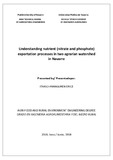Mostrar el registro sencillo del ítem
Understanding nutrient (nitrate and phosphate) exportacion processes in two agrarian watersheds in Navarre
| dc.coverage.spatial | east=-1.779298400000016; north=42.95834500000001; name=Navarra, España | |
| dc.creator | Aranguren Erice, Itxaso | es_ES |
| dc.date.accessioned | 2018-06-29T13:50:49Z | |
| dc.date.available | 2018-06-29T13:50:49Z | |
| dc.date.issued | 2018 | |
| dc.identifier.uri | https://hdl.handle.net/2454/29041 | |
| dc.description.abstract | El cultivo de secano cubre la mayor superficie arable de Navarra, contribuyendo en más del 60% en la producción de cultivos. En este estudio se analizan los datos (de octubre de 2006 a septiembre de 2016) de caudal y de calidad de agua en dos cuencas agrarias similares en cuanto a clima y manejo agrícola del Gobierno de Navarra que representan las condiciones de cultivos secanos de la zona media de Navarra (La Tejería, 169 ha, y Latxaga, 207 ha), con el fin de entender las diferencias en la dinámica de nutrientes citadas en estudios anteriores. El caudal anual en la cuenca de Latxaga (≈250 mm/año) fue mayor que en La Tejería (≈222 mm/año). Las concentraciones (≈70 mg/L) y las exportaciones de nitrato (32 kg N/ha/año) fueron mayores en La Tejería en comparación con las obtenidas en Latxaga (≈20 mg/L y 17 kg N/ha/año respectivamente). De manera similar, las concentraciones (0.12 mg/L) y exportaciones (0.05 kg P/ha/año) de fosfato fueron mayores en La Tejería (0.07 mg/L y 0.03 kg P/ha/año en Latxaga). Mediante revisiones bibliográficas, se evaluó la influencia de diferentes factores (condiciones climáticas, los suelos, la fertilización, la forma de las cuencas, la vegetación riparia, la distribución de zonas improductivas y el drenaje subsuperficial) en las dinámicas del nitrato y el fosfato, siendo los últimos tres factores citados los que desempeñan probablemente el papel más importante en la exportación de nitratos. Las diferentes exportaciones de sedimentos entre las dos cuencas probablemente explican las diferentes exportaciones de fosfato obtenidas. | es_ES |
| dc.description.abstract | Rainfed land covers most of Navarre arable land surface, contributing with over 60% of the crop production. In this study, the discharge and water quality data collected during October 2006- September 2016 by the Government of Navarre in two watersheds with rather similar climate and agricultural management representing typical rainfed conditions in the middle Navarre (La Tejería, 169 ha, and Latxaga, 207 ha) were analyzed to understand significant differences in nutrient dynamics previously reported for these watersheds. Annual discharge was higher in Latxaga watershed (≈250 mm/year) than in La Tejería (≈222 mm/year). Median nitrate concentration (≈70 mg/L) and nitrate export (≈32 kg N/ha/year) in La Tejería were higher than those recorded in Latxaga (≈20 mg/L and 17 kg N/ha/year, respectively). Similarly, phosphate concentration (≈0.12 mg/L) and export (≈0.05 kg P/ha/year) were higher in La Tejería than in Latxaga (≈0.07 mg/L and 0.03 kg P/ha/year). The influence in the nitrate and phosphate dynamics of different factors such as climate, soils, fertilization, shape of the watersheds, riparian vegetation, distribution of unproductive areas and subsurface drainage were assessed through a literature review. The factors that most likely play the main role in the higher nitrate export in La Tejería are the presence of tile drainage, the minor potential of riparian areas to decrease nitrate load and the proportion and location of unproductive areas. Phosphate dynamics in these watersheds are probably controlled by sediment dynamics and the differences in sediment exports between La Tejería and Latxaga suffices to explain the differences in phosphate exports. | es_ES |
| dc.format.mimetype | application/pdf | en |
| dc.language.iso | eng | en |
| dc.subject | Impacto medioambiental | es_ES |
| dc.subject | Agricultura de secano | es_ES |
| dc.subject | Dinámicas de los nutrientes disueltos | es_ES |
| dc.subject | Uso del terreno | es_ES |
| dc.subject | Environmental impact | es_ES |
| dc.subject | Rainfed agriculture | es_ES |
| dc.subject | Dissolved nutrients dynamics | es_ES |
| dc.subject | Land use | es_ES |
| dc.title | Understanding nutrient (nitrate and phosphate) exportacion processes in two agrarian watersheds in Navarre | en |
| dc.type | Trabajo Fin de Grado/Gradu Amaierako Lana | es |
| dc.type | info:eu-repo/semantics/bachelorThesis | en |
| dc.date.updated | 2018-06-28T12:25:00Z | |
| dc.contributor.affiliation | Escuela Técnica Superior de Ingenieros Agrónomos | es_ES |
| dc.contributor.affiliation | Nekazaritza Ingeniarien Goi Mailako Eskola Teknikoa | eu |
| dc.description.degree | Graduado o Graduada en Ingeniería Agroalimentaria y del Medio Rural por la Universidad Pública de Navarra | es_ES |
| dc.description.degree | Nekazaritzako Elikagaien eta Landa Ingurunearen Ingeniaritzan graduatua Nafarroako Unibertsitate Publikoan | eu |
| dc.rights.accessRights | Acceso abierto / Sarbide irekia | es |
| dc.rights.accessRights | info:eu-repo/semantics/openAccess | en |
| dc.contributor.advisorTFE | Merchán Elena, Daniel | es_ES |
| dc.contributor.advisorTFE | Casalí Sarasíbar, Javier | es_ES |
| dc.subject.geo | Ingeniería agroalimentaria | es_ES |


